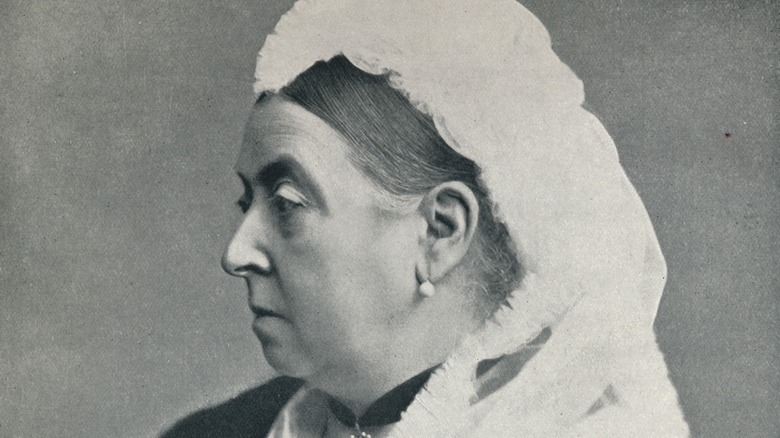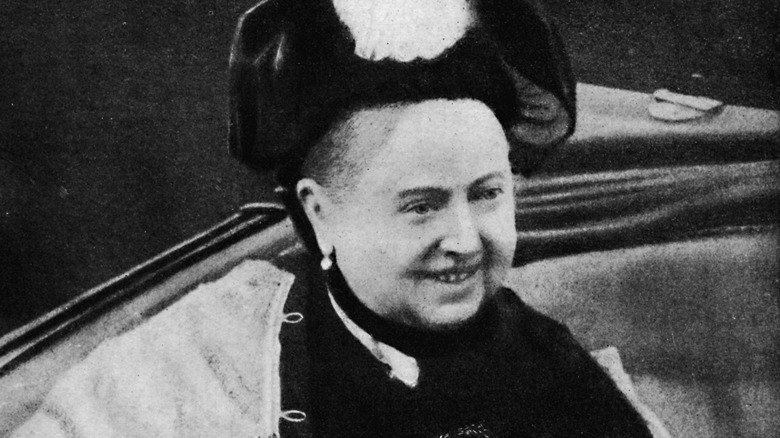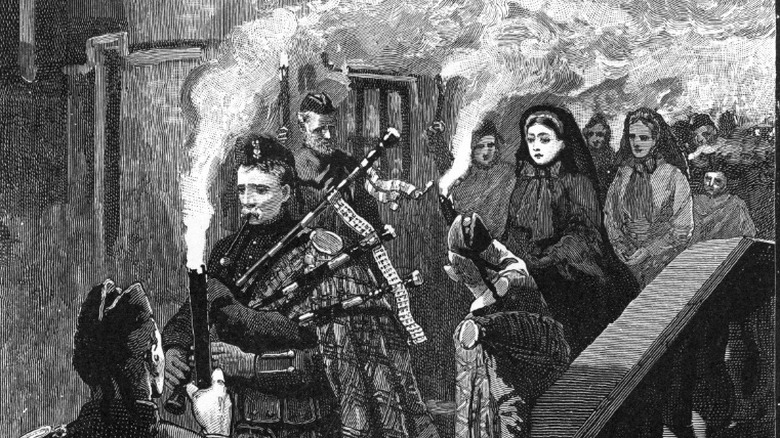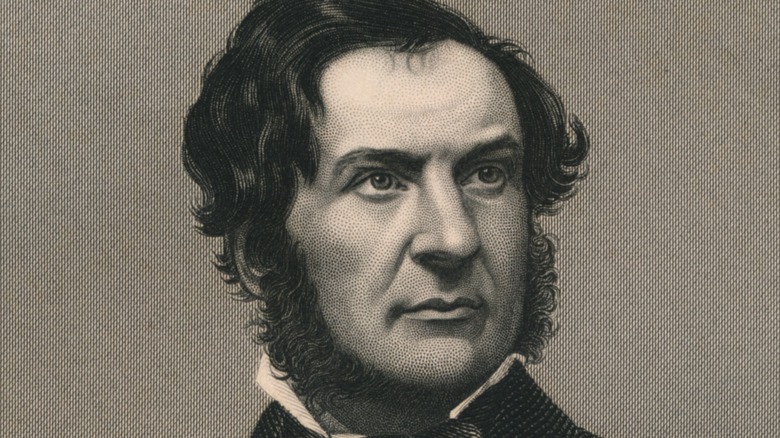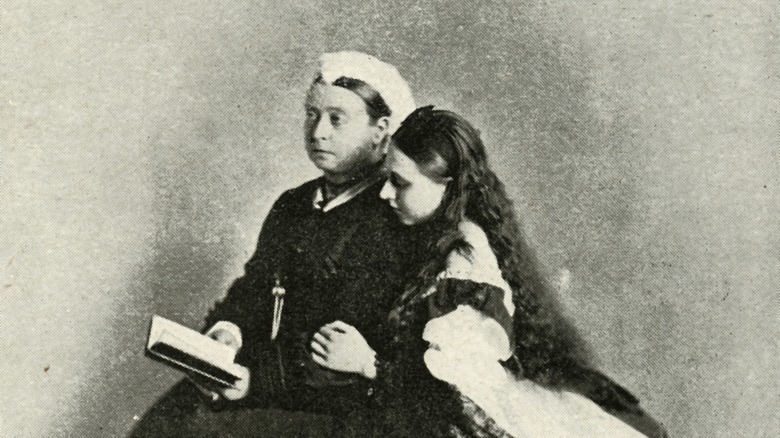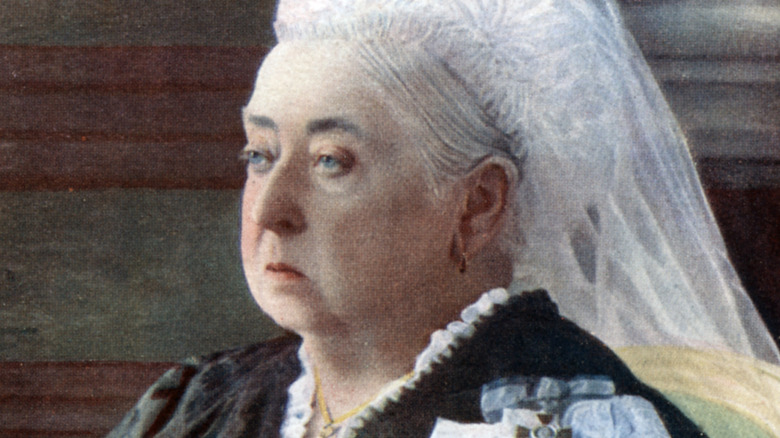What Was It Like To Celebrate Halloween With Queen Victoria?
Celebrated in one form or another since the days of the Roman Empire, the Halloween holiday as we know it today is a time for young children to dress up in fanciful, sometimes frightening costumes to knock on a neighbor's door and collect a sweet treat, as History notes. Though much of the ancient folklore behind Halloween was around during the reign of Queen Victoria — lasting from 1837 through her death in 1901, per the Royal Family website — the more conservative, Christian-based standards of that era meant some looked down upon the more supernatural aspects of the holiday.
As Hanger London writes, the queen herself loved Halloween, though — sometimes called Hallowe'en in her day — much to the dismay of those in English high society. For decades, in fact, Victoria, to the delight of those nearby, threw her own Halloween celebrations far from the watchful eye of the English court many miles away from London in Scotland. From bonfires to dancing, here's what it was like to celebrate Halloween with Queen Victoria.
Victoria loved folktales and legends
Queen Victoria's interest in Halloween makes some sense, given the fact she was widely known to be superstitious, with an interest in the folktales and legends of the British isles, as Reader's Digest notes. For example, Victoria thought it unlucky to get married in May. Beliefs of this sort were common in Victoria's time, but it was considered inappropriate by some for a reigning British monarch and head of the Christian Church of England to ascribe to such philosophies, many of which were of pre-Christian origin, as Hanger London notes.
Victoria's first documented exposure to a Halloween celebration was in Scotland, where the Celtic holiday called Samhain once flourished, a celebration upon which many modern Halloween traditions are based. For this reason, Scottish Halloween celebrations remain popular to this day, according to Historic UK. In 1866, while visiting Mrs. Grant the mother of the Balmoral Castle groundskeeper on October 31, a longtime royal Scottish residence, Victoria noticed torch-carrying children and bonfires in the nearby hills. In her so-called "Highland Journals" Victoria wrote those flames "had a pretty effect."
The queen traveled frequently to Scotland for Halloween
Once introduced to the Halloween tradition in Scotland, Victoria would travel to Balmoral Castle with her youngest children each year for the holiday, as Scottish Field explains. Over time, Halloween was not-to-be-missed for Victoria and her family, and royal Halloween celebrations at Balmoral Castle grew more elaborate. One year, her son, young Prince Leopold, who was ill, had his bed pushed near a window in the queen's bedroom so that he could still view the festivities.
On any given year the Halloween celebration at Balmoral would include lighting a bonfire, dancing, and torch lighting. Victoria's interest in the holiday many miles away from London did not go unnoticed in the press. The Scottish newspaper, the "Bury and Norwich Post" wrote that Victoria's Halloween tradition fostered "a form of superstition which still has much hold on the ignorant in some parts of her Majesty's dominions" (via Scottish Field).
Effigies were also burned at Balmoral
From there, Queen Victoria became so closely associated with the Halloween tradition at Balmoral it came to be known as the "Queen's Halloween," per Hanger London. Among other aspects of the festivities was a large bonfire burned in front of Balmoral in which an effigy of a witch known as "shandry dann" was tossed on the flames by a servant of the queen, dressed as a hobgoblin, while bagpipes also played, according to History Collection.
The annual burning of the effigy grew to include a mock trial scenario during which poor "shandry dann" was never found innocent. Soon, other "demon" effigies were burned, including one that looked uncomfortably close to then-British Prime Minister, William Ewart Gladstone (pictured), with whom Victoria reportedly had a poor relationship. There were processions led by the queen and a piper with as many as 100 local residents, with reels — a type of traditional Scottish dancing — and bagpipes. In 1877, Victoria wrote in her journal that the costume of her daughter, Princess Louise, looked "something like one of the witches in Macbeth," per Scottish Field.
Victoria's trips to Scotland for Halloween were controversial
As previously mentioned, Victoria's fervent interest in Halloween — a holiday with pagan origins — offended some in the English upper classes. It was also noted that Victoria's frequent trips to Balmoral took her many miles away from London, the seat of the British government. Visiting in both summer and autumn, Victoria controversially grew close to a man named John Brown, a Highland ghillie — something like a traditional Scottish nature guide or outdoorsman, as the BBC explains. Their relationship reportedly blossomed after the death of Victoria's husband, Prince Albert.
In 1881, the Dundee Advertiser, a newspaper, recorded what one effigy burning was like. Via Scottish Field, their report described the bonfire as it was lit by Victoria's daughter, Princess Beatrice (pictured with her mother, above). The effigy was then put on trial in front of the bonfire, with attendees dressed in all manner of costumes. Upon sentencing, the witch was dragged from the car it was brought forth in, "hurled into the flames," and quickly reduced to ashes "amidst the shrieks and howls of the assembled 'spirits'," the Dundee Advertiser wrote.
Victoria celebrated Halloween less and less later in her life
All told, the Queen Victoria Halloween celebrations at Balmoral sometimes grew out of control. In 1874, in fact, the planned dance party in the Balmoral ballroom was called off by the queen for fear partygoers were too riled up, as Scottish Field notes. No one's quite sure why but beginning in 1883, around the same time that John Brown himself died, the queen's favorite "ghillie" with whom she'd purportedly grown close, the queen and her family traveled to Scotland less and less for Halloween at Balmoral.
Perhaps as a result, or simply as a coincidence, Scottish interest in Halloween in this period would also decline. But that lull would not be long lasting. Today, Halloween is widely celebrated all across Scotland, with a blend of modern traditions, festivities that Queen Victoria and the royal family may find familiar, and other practices dating to the time of one root of the Halloween holiday itself: Samhain, as Historic UK explains.
